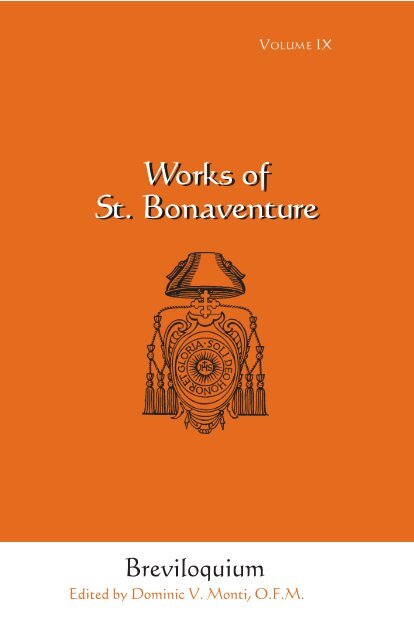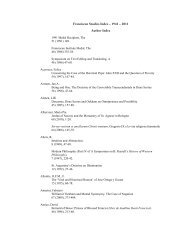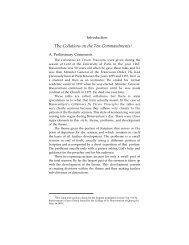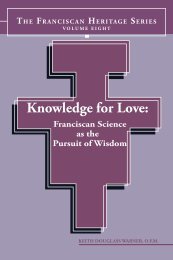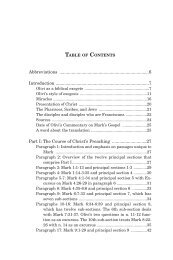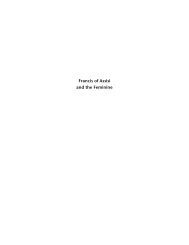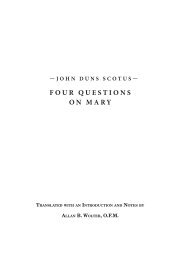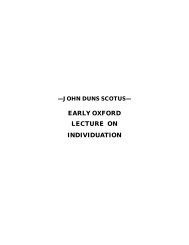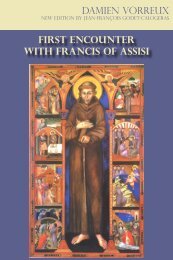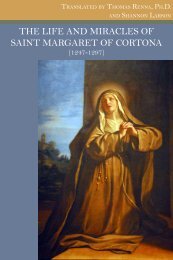Works of St. Bonaventure Works of St. Bonaventure - Franciscan ...
Works of St. Bonaventure Works of St. Bonaventure - Franciscan ...
Works of St. Bonaventure Works of St. Bonaventure - Franciscan ...
Create successful ePaper yourself
Turn your PDF publications into a flip-book with our unique Google optimized e-Paper software.
VOLUME IX<strong>Works</strong> <strong>of</strong><strong>St</strong>. <strong>Bonaventure</strong>BreviloquiumEdited by Dominic V. Monti, O.F.M.
WORKS <strong>of</strong>ST. BONAVENTUREBREVILOQUIUM
BONAVENTURETEXTS IN TRANSLATIONSERIESGeneral EditorRobert J. Karris, O.F.M.Volume IXBREVILOQUIUM<strong>Franciscan</strong> Institute PublicationsSaint <strong>Bonaventure</strong> University2005
WORKS <strong>of</strong>ST. BONAVENTUREBREVILOQUIUMIntroduction, Translation and Notesby Dominic V. Monti, O.F.M.<strong>Franciscan</strong> Institute PublicationsThe <strong>Franciscan</strong> InstituteSaint <strong>Bonaventure</strong> UniversitySaint <strong>Bonaventure</strong>, NY 147782005
Copyright © 2005The <strong>Franciscan</strong> Institute<strong>St</strong>. <strong>Bonaventure</strong> University<strong>St</strong>. <strong>Bonaventure</strong>, New YorkAll rights reserved.No part <strong>of</strong> the book may be reproduced or transmitted in anyform or by any means, electronic or mechanical, withoutpermission in writing from the publisher.Library <strong>of</strong> Congress Control Number: 2005932513ISBN: 1576591999Printed in the United <strong>St</strong>ates <strong>of</strong> AmericaBookmasters, Inc.Ashland, Ohio
CONTENTSPREFACE ...................................................................... ixINTRODUCTION ............................................................ xiiiPROLOGUE ..................................................................... 1The Breadth <strong>of</strong> Holy Scripture .................................. 5The Length <strong>of</strong> Holy Scripture ................................... 8The Height <strong>of</strong> Holy Scripture .................................. 11The Depth <strong>of</strong> Holy Scripture ................................... 13The Mode <strong>of</strong> Procedure <strong>of</strong> Holy Scripture .............. 17The Mode <strong>of</strong> Expounding Holy Scripture ............... 19The Chapters <strong>of</strong> the Breviloquium.......................... 23Part One: On the Trinity <strong>of</strong> God .............................. 27A Summary <strong>of</strong> the Seven Topics <strong>of</strong> Theology .......... 27What We Must Hold Concerning the Trinity<strong>of</strong> Persons and the Unity <strong>of</strong> Essence ................. 29The Right Understanding <strong>of</strong> This Belief ................ 33The Catholic Expression <strong>of</strong> This Belief ................... 37The Unity <strong>of</strong> the Divine NatureIn Relation to a Diversity <strong>of</strong> Manifestations .... 41The Unity <strong>of</strong> the Divine NatureIn Relation to Multiple Appropriations ............ 44God’s Omnipotence .................................................. 47God’s Wisdom, Predestination,and Foreknowledge ............................................ 49God’s Will and Providence ....................................... 53
INTRODUCTIONVIIThe Incarnation in Regardto the Union <strong>of</strong> Natures ................................... 135How the Incarnation Came About ........................ 139The Incarnation in the Fullness <strong>of</strong> Time .............. 143The Fullness <strong>of</strong> Grace in ChristConsidered in the Gifts in His Affections ....... 146The Fullness <strong>of</strong> Wisdomin the Intellect <strong>of</strong> Christ .................................. 150The Perfection <strong>of</strong> Merit in His Deeds.................... 154The Passion <strong>of</strong> Christ:The Condition <strong>of</strong> the One Who Suffered ......... 157The Passion <strong>of</strong> Christ:The Nature <strong>of</strong> His Sufferings .......................... 160The Passion <strong>of</strong> Christ:The Effects <strong>of</strong> His Sufferings........................... 164Part Five: On the Grace <strong>of</strong> the Holy Spirit ........... 169Grace as a Gift <strong>of</strong> God............................................ 169Grace as the Condition <strong>of</strong> Meritorious Acts ......... 173Grace Considered as a Remedy for Sin................. 178How Grace Branches OutInto the Habits <strong>of</strong> the Virtues ......................... 183How Grace Branches OutInto the Habits <strong>of</strong> the Gifts ............................. 187How Grace Branches Out into the Habits<strong>of</strong> the Beatitudes and Consequently<strong>of</strong> the Fruits and <strong>of</strong> the Spiritual Senses ........ 191The Exercise <strong>of</strong> Grace as RegardsWhat is to be Believed ..................................... 196The Exercise <strong>of</strong> Grace as RegardsWhat is to be Loved ......................................... 200The Exercise <strong>of</strong> Grace as RegardsObserving the Precepts and Counsels ............ 203The Exercise <strong>of</strong> Grace as RegardsPetition and Prayer .......................................... 206
VIIIST. BONAVENTURE’S BREVILOQUIUMPart Six: On the Sacramental Remedy ................. 211The Source <strong>of</strong> the Sacraments .............................. 211How the Sacraments Have Varied ........................ 214The Number and Division <strong>of</strong> the Sacraments ...... 218The Institution <strong>of</strong> the Sacraments ........................ 221The Administration <strong>of</strong> the Sacraments ................ 225The Repetition <strong>of</strong> the Sacraments ........................ 229The Nature and Integrity <strong>of</strong> Baptism ................... 232On the Integrity <strong>of</strong> Confirmation .......................... 235The Integrity <strong>of</strong> the Eucharist .............................. 238The Integrity <strong>of</strong> Penance ....................................... 245The Integrity <strong>of</strong> Extreme Unction ........................ 250The Integrity <strong>of</strong> Orders.......................................... 254The Integrity <strong>of</strong> Matrimony .................................. 258Part Seven: On the Repose<strong>of</strong> the Final Judgment ..................................... 265The Judgment in General...................................... 265The Antecedents <strong>of</strong> the Judgment:The Punishment <strong>of</strong> Purgatory ......................... 269The Antecedents <strong>of</strong> the Judgment:The Suffrages <strong>of</strong> the Church ........................... 273The Concomitants <strong>of</strong> the Judgment:The Conflagration <strong>of</strong> Fire ................................ 277The Concomitants <strong>of</strong> the Judgment:The Resurrection <strong>of</strong> Bodies.............................. 281The Consequents to the Judgment:The Infernal Punishment ................................ 286The Glory <strong>of</strong> Paradise ............................................ 290IndicesOf Scripture Passages ............................................ 303Of Church Fathers, EcclesiasticalAuthors, and GlossaeOf Philosophers, Jurists, and Historians
INTRODUCTIONIXPREFACEThe origins <strong>of</strong> this book go back almost a decade. Ihad recently completed an earlier volume in this series, 1when Brother Edward Coughlin, then Director <strong>of</strong> the<strong>Franciscan</strong> Institute, asked me if I would consider translatingthe Breviloquium. I accepted his invitation, workingat it over the past years, amidst countless interruptionsdue to more immediate tasks and other responsibilities.When I first mentioned this project to my formerpr<strong>of</strong>essor, Bernard McGinn, he remarked: “Great! Wereally need a good annotated translation <strong>of</strong> theBreviloquium.” I soon discovered what he meant. Aftercompleting a few <strong>of</strong> the chapters in Part 1, I found myselfsaying, “I’m translating <strong>Bonaventure</strong>’s Latin intoEnglish, and it’s still all Greek!” I had encountered formyself the remarkable “concentration <strong>of</strong> word andphrase” that Jacques G. Bougerol felt characterized thiswork. 2 In it <strong>Bonaventure</strong>’s style is “simultaneously compactand highly complex; his sentences are long andstately, with rhythmically balanced phrases,” 3 makingit very difficult to render into contemporary English.1Writings Concerning the <strong>Franciscan</strong> Order, The <strong>Works</strong> <strong>of</strong> Saint<strong>Bonaventure</strong> V (<strong>St</strong>. <strong>Bonaventure</strong>, NY: The <strong>Franciscan</strong> Institute, 1994).2Jacques Guy Bougerol, Introduction to the <strong>Works</strong> <strong>of</strong> <strong>Bonaventure</strong>,trans. José de Vinck (Paterson, N.J.: <strong>St</strong>. Anthony Guild Press, 1963).3Paula Jean Miller, “Marriage: The Sacrament <strong>of</strong> Divine-HumanCommunion: Vol. I: A Commentary on <strong>St</strong>. <strong>Bonaventure</strong>’s Breviloquium,”(Quincy, IL: <strong>Franciscan</strong> Press, 1995), 6.
XST. BONAVENTURE’S BREVILOQUIUMFurthermore, the work is packed with technical medievaltheological terms that seem like meaningless jargonto many contemporary readers unfamiliar withScholastic categories. This led me to adopt an approachwith which Father Zachary Hayes, who was named generaleditor <strong>of</strong> this series while my work was already inprogress, fully agreed. And so I have not simply provideda translation, with a few basic notes indicating<strong>Bonaventure</strong>’s major sources, as did the previous 1962English translation <strong>of</strong> José de Vinck 4 and the 1996 Italiantranslation in the Opera di San Bonaventura series.5 Rather, I attempted to compose content notes aswell, so that the reader might refer immediately to anexplanation <strong>of</strong> an otherwise problematic passage. Inlight <strong>of</strong> the extensive notes in the body <strong>of</strong> the translation,the introduction to the volume is relatively modest,providing a general orientation to the work, its placein <strong>Bonaventure</strong>’s overall theological effort, and someinterpretative keys for the reader approaching it.This project has taken a long time to reach fruitionand I have many people to thank for their assistance overthe years. First <strong>of</strong> all, I acknowledge the Washington TheologicalUnion for generously providing two semester-longsabbaticals, in 1997 and again in 2001, in which I did thebulk <strong>of</strong> the translation and notes. I am grateful, too, forthe encouragement <strong>of</strong> my colleagues on the <strong>Bonaventure</strong>Texts in Translation Board, especially for the leadership<strong>of</strong> Zachary Hayes, who carefully edited the translation.No one knows <strong>Bonaventure</strong>’s thought better than he, and4The Breviloquium, trans. José de Vinck, <strong>Works</strong> <strong>of</strong> <strong>St</strong>. <strong>Bonaventure</strong>II (Paterson, NJ: <strong>St</strong>. Anthony Guild Press, 1962).5Breviloquio, trans. Mariano Aprea, Opera San Bonaventura: OpuscoliTeologici, 2 (Rome: Città Nuova Editrice, 1996).
INTRODUCTIONXIthat fact helped greatly in capturing the most appropriatetranslation. Over the past several years, a number <strong>of</strong>scholars have used drafts <strong>of</strong> this translation in theirclasses: Ilia Delio <strong>of</strong> the Washington Theological Union,Michael Blastic and Oleg Bychkov <strong>of</strong> <strong>St</strong>. <strong>Bonaventure</strong>University, and Wayne Hellmann at Saint Louis University.They have detected a number <strong>of</strong> errors and made somehelpful suggestions for which I am most grateful. In particular,I would like to acknowledge Pr<strong>of</strong>essor JamesGinther <strong>of</strong> Saint Louis for alerting me to <strong>Bonaventure</strong>’sdependence on a work <strong>of</strong> Robert Grosseteste in the Prologue.And I must thank the editors <strong>of</strong> <strong>Franciscan</strong> InstitutePublications for their patience as I brought this effortto completion.This year marks my fortieth anniversary as a pr<strong>of</strong>essed<strong>Franciscan</strong> friar. As I look back over these years, my brothersin Holy Name Province deserve my special thanks fortheir constant affection and support. To them I dedicatethis book. In a particular way, I will be ever grateful tothose who encouraged my gifts during my formation years:Reginald Redlon, Boniface Hanley, Hugh Eller, DamianMcElrath, Alexander DiLella, Regis Duffy, and VincentCushing.Iuveni quaerenti lucemExempla erant et magistriDominic V. Monti, O.F.M.<strong>St</strong>. <strong>Bonaventure</strong> UniversityFeast <strong>of</strong> the Holy Trinity, 2005
XIIST. BONAVENTURE’S BREVILOQUIUMABBREVIATIONSACPGPLVgWSAAnselm <strong>of</strong> Canterbury: The Major <strong>Works</strong>. Editedby Brian Davies and G. R. Evans. Oxford andNew York: Oxford University Press, 1998.Patrologiae cursus completus. Series graeca. Editedby J. P. Migne. Paris, 1857-66. 161 volumes.Patrologiae cursus completus. Series latina. Editedby J. P. Migne. Paris, 1844-64. 221 volumes.Vulgate version <strong>of</strong> the Christian Bible. See BibliaSacra iuxta Vulgatem Versionem. Edited by RobertWeber et al. <strong>St</strong>uttgart: Deutsche Bibelgesellschaft,1983.<strong>Works</strong> <strong>of</strong> Saint Augustine. Edited by John E. Rotelle,O.S.A. Hyde Park, NY: New City Press, 1991- .
INTRODUCTIONXIIIINTRODUCTIONThe Breviloquium and the Itinerarium mentis in Deumare undoubtedly the two works <strong>of</strong> the Seraphic Doctor thathave received the most sustained admiration over the centuries.To judge by the number <strong>of</strong> extant copies, theBreviloquium was the more popular <strong>of</strong> the two works inthe Middle Ages, surviving in some 227 manuscripts. 1 JeanGerson, Chancellor <strong>of</strong> the University <strong>of</strong> Paris, was one <strong>of</strong>those who testified to their impact:Two works <strong>of</strong> <strong>Bonaventure</strong> are composed with sucha divine art <strong>of</strong> synthesis that nothing at all surpassesthem, namely the Breviloquium and theItinerarium. . . .More than thirty years ago, I choseto familiarize myself with these two small treatises;since then I have read them <strong>of</strong>ten, frequently meditatingon certain passages and even specific words.Now, at my age, I have the leisure to achieve myfondest desire: to begin to experience them afresh,for to me they always seem ever-new and enchanting.21The Itinerarium survives in some 138 manuscripts. DoctorisSeraphici Sancti Bonaventurae . . . Opera Omnia V (Quaracchi:Collegium S. Bonaventurae, 1882-1902), xvii-xxxiii. Hereafter thisedition will be referred to simply by the volume and page numberswithin parentheses.2J. Gerson, De libris legendis a monacho, 5-6, Opera J. Gerson(<strong>St</strong>rasbourg, 1515), Fol. XIX, G.
INTRODUCTIONXVaccept the common dating <strong>of</strong> 1257, then, as fairly certain. 8This is significant, for during that year <strong>Bonaventure</strong> wascoming to grips with a dramatic transition in his own life,as he moved from a university career to one <strong>of</strong> major pastoralresponsibility. Within his literary corpus therefore,the Breviloquium occupies a pivotal position; in the words<strong>of</strong> one recent study, it is a “turning-point text or a borderlinetext” standing between two worlds. 9From one perspective, it is rightly viewed as thecapstone <strong>of</strong> <strong>Bonaventure</strong>’s twenty-year career as studentand teacher at the University <strong>of</strong> Paris. 10 He had arrived inthe city in 1235 as a young student <strong>of</strong> arts. After completinghis master’s degree in 1243, he had joined the FriarsMinor at Paris. His superiors quickly recognized his talents;after completing his novitiate year, he immediatelycommenced his theological education at the <strong>Franciscan</strong>School. One <strong>of</strong> the few friar students there actually matriculatingfor the University degree, <strong>Bonaventure</strong> beganlecturing on the Bible in 1248, gradually progressing tothe point where he assumed the duties <strong>of</strong> regent master<strong>of</strong> the <strong>Franciscan</strong> School <strong>of</strong> theology early in 1254. During<strong>of</strong> wisdom <strong>of</strong> Christ’s human intellect (pt. 4, chap. 6). This clearly reflectshis Disputed Questions on the Knowledge <strong>of</strong> Christ, q. 7 (V, 37-43). Thisis a significant advance from his earlier position in the SentencesCommentary (3.14.2.3 [V, 312-317).8Camille Bérubé is an exception to this consensus; he does not believethe Troyes manuscript is decisive, and would prefer a date several yearslater – perhaps after the Itinerarium (1259) (De la philosophie a lasagesse chez Saint <strong>Bonaventure</strong> et Roger Bacon [Rome: Istituto <strong>St</strong>oricodei Cappuccini, 1976]), 117-118.9Emmanuel Falque, Saint <strong>Bonaventure</strong> et l’entrée de Dieu in théologie.Études de philosophie médiévale (Paris: Librairie philosophique J. Vrin,2000), 25: “un texte charnière ou un texte frontière.”10For a good brief summary <strong>of</strong> <strong>Bonaventure</strong>’s career, see J. F. Quinn,“<strong>Bonaventure</strong>, <strong>St</strong>.,” in Dictionary <strong>of</strong> the Middle Ages, ed. Joseph R.<strong>St</strong>rayer (New York: Charles Scribner’s Sons, 1983), 2:313-319.
XVIST. BONAVENTURE’S BREVILOQUIUMhis teaching career, <strong>Bonaventure</strong> utilized the increasinglysophisticated techniques that had been developed over thepreceding century in the urban theology schools <strong>of</strong> WesternEurope we know as Scholasticism. 11 The most fundamental<strong>of</strong> these techniques was that <strong>of</strong> methodical commentaryon authoritative texts (lectio); the second, the systematicanalysis and resolution <strong>of</strong> doctrinal and moral issuesarising from those texts (quaestio and disputatio).<strong>Bonaventure</strong> proved himself a master <strong>of</strong> these techniquesin his commentaries on the Biblical books <strong>of</strong> Ecclesiastes,Luke, and John; his massive commentary on the FourBooks <strong>of</strong> Sentences <strong>of</strong> Peter Lombard; and three series <strong>of</strong>disputed questions. But Scholastic theologians had alsopioneered a third technique: the attempt to synthesize thediffuse results <strong>of</strong> lectio, quaestio and disputatio into a coherentand comprehensive presentation <strong>of</strong> Christian doctrinefor instructional purposes. This was the task<strong>Bonaventure</strong> set for himself in the Breviloquium, and inthis regard it stands unique among his works, presentinga concise synthesis <strong>of</strong> his mature teaching. But the reasonsfor its publication were not purely academic.In 1257 <strong>Bonaventure</strong>’s pr<strong>of</strong>essional teaching careereffectively came to an end, for in February <strong>of</strong> that year the<strong>Franciscan</strong> general chapter had elected him General Minister<strong>of</strong> the Order. The pressing responsibilities <strong>of</strong> that <strong>of</strong>ficesoon demanded his full attention. The Friars Minorwere just beginning to emerge from a serious crisis inwhich their opponents, the secular masters <strong>of</strong> the Universitytheology faculty, articulating the complaints <strong>of</strong> many<strong>of</strong> the clergy <strong>of</strong> Western Europe, had mounted a sustainedattack on the new mendicant orders’ pastoral ministry in11My description <strong>of</strong> the scholastic method draws on Bernard McGinn,The Growth <strong>of</strong> Mysticism, vol. 2 <strong>of</strong> The Presence <strong>of</strong> God: A History <strong>of</strong>Western Christian Mysticism (New York: Crossroad, 1994), 367-374.
INTRODUCTIONXVIIthe church, indeed on their entire way <strong>of</strong> life. 12 Given thisvolatile situation, <strong>Bonaventure</strong> wisely decided to maintainhis principal residence at Paris for the next severalyears. Although he had traveled to Italy to confer withPope Alexander IV after having received word <strong>of</strong> his election,he quickly returned to Paris. There, in August,<strong>Bonaventure</strong> and his Dominican colleague, ThomasAquinas, were grudgingly accepted by the consortium <strong>of</strong>masters <strong>of</strong> theology into their number, marking an end tothe long and bitter controversy. <strong>Bonaventure</strong> could thenoversee the transfer <strong>of</strong> his seat in theology to his successor,Gilbert <strong>of</strong> Tournai. 13 It is <strong>Bonaventure</strong>’s new responsibilitiesas General Minister <strong>of</strong> the <strong>Franciscan</strong> Order thatprovide another vantage point from which to view theBreviloquium, one that allows us to appreciate it as morethan simply an academic contribution to theology. Overhis years <strong>of</strong> teaching, <strong>Bonaventure</strong> had become convincedthat there was a critical need in the education <strong>of</strong> youngfriars, and in this work he attempted to supply it. 14Why was a book like this necessary? By the 1250’s, thenumber <strong>of</strong> <strong>Franciscan</strong>s engaged in formal studies had increasedexponentially. In virtually every large friary a lectorwas assigned to teach theology to the clerical members12For a good recent summary <strong>of</strong> the conflict at Paris, see Bert Roest,A History <strong>of</strong> <strong>Franciscan</strong> Education, c.1210-1517 (Leiden: Brill, 2000),51-57. The standard detailed history <strong>of</strong> this earlier phrase <strong>of</strong> thisprotracted conflict is M.-M. Dufeil, Guillaume de Saint Amour et lapolémique universitaire parisienne, 1250-1259 (Paris: Editions A. et J.Picard, 1972).13For details, see my introduction to Volume 5 in this series, WritingsConcerning the <strong>Franciscan</strong> Order (<strong>St</strong>. <strong>Bonaventure</strong>, NY: The <strong>Franciscan</strong>Institute, 1994), 21-32.14In this sense, the Breviloquium may be compared to another work<strong>Bonaventure</strong> supplied for the formational needs <strong>of</strong> friars, the Regulanovitiorum. Cf. Roest, 243-250.
XVIIIST. BONAVENTURE’S BREVILOQUIUM<strong>of</strong> the community so they would be well-equipped for theirprimary ministry <strong>of</strong> preaching and hearing confessions.Theology classes were an integral part <strong>of</strong> their weekly schedule.This created a constant demand for qualified friars toserve as lectors. To meet it, promising young friars wereassigned to pursue theological studies at schools the Orderhad established, not only at the universities <strong>of</strong> Paris, Oxford,and Cambridge, but also in more than a dozen otherstudia generalia (general study centers) that had sprungup by this time. 15 The curriculum in these other study centerslargely replicated that <strong>of</strong> the university faculties <strong>of</strong>theology. To be qualified as a lector, a friar had to studytheology for four years. For the first two he attended lectureson the Bible, then two more on the Four Books <strong>of</strong> Sentences<strong>of</strong> Peter Lombard. 16 This was a top-notch educationfor the time, a fact recognized by a Papal privilege<strong>Bonaventure</strong> obtained shortly after his election that grantedstudents who had completed the curriculum at the Order’sstudia generalia a license to teach theology, thus grantingthem an equivalent <strong>of</strong> a university degree. 17However, by today’s standards, young friars in the1250’s were singularly unequipped to embark on theologi-15Roest, 6-42. In addition to the three <strong>Franciscan</strong> schools that wereincorporated into University theology faculties, by the 1250’s studyhouses had been established in Bologna, Padua, Florence, Perugia,Naples, Toulouse, Montpellier, Dijon, Magdeburg, Cologne, Regensburg,<strong>St</strong>rasbourg, and Erfurt. These schools were ‘general’ in the sense thatthey attracted friar students from beyond their own provinces, eventhough some were effectively only regional. We are not certain preciselywhen each <strong>of</strong> these studia was <strong>of</strong>ficially designated ‘general.’ It isimportant to note that these study centers also were open to secularclergy. For the legislation governing the studia, see the Constitutions<strong>of</strong> Narbonne, 6.12-24 in <strong>Works</strong> <strong>of</strong> <strong>St</strong>. <strong>Bonaventure</strong> 5: 101-103 (note 127on p. 102 must be corrected in light <strong>of</strong> Roest’s study).16Roest, 87-97, 133-137.17Exultante spiritu (23 March 1257), Bullarium <strong>Franciscan</strong>um, 2:208b,n. 317. Cf. Roest, 31.
INTRODUCTIONXIXcal studies. We have to remember that parishes providedno formal religious instruction in the Middle Ages; catechismsdesigned for the religious education <strong>of</strong> youth wouldonly be a product <strong>of</strong> the reforming spirit <strong>of</strong> the sixteenthcentury. In terms <strong>of</strong> exposure to the elements <strong>of</strong> Christiandoctrine, candidates joining the Order might know onlythe Apostles’ Creed. Certainly, during their novitiate year,young friars would be immediately immersed in a Biblicallybased religious culture. The daily rounds <strong>of</strong> the Liturgy<strong>of</strong> the Hours demanded that novices commit thePsalms to memory; they also quickly gained familiaritywith other Biblical texts that occurred in the liturgy andthe communal readings during meals. In addition, theywould <strong>of</strong>ten hear thematic sermons that would elucidatedoctrinal topics. 18 <strong>St</strong>ill, they would never have been exposedto any formal theological instruction. This situationwas complicated by the fact that many young candidateswere entering the Order after at least several years <strong>of</strong>university training. 19 Their exposure to secular learning,both in terms <strong>of</strong> content and method, thus far exceededtheir knowledge <strong>of</strong> their faith. Furthermore, the standardtextbooks in theology – the Bible and Peter Lombard’sSentences – did not present the same scientific clarity astextbooks in the arts, with their clear outlines and definiteobjectives. The Bible appeared to be a confusing andcontradictory collection <strong>of</strong> stories, the Sentences a disorganizedassemblage <strong>of</strong> arcane and sterile questions. Wasthere some unity and coherence in this subject matter –18Roest, 250-258.19Already, the Order had passed legislation about 1242 mandatingthat no one should be admitted as a friar without having receivedcompetent instruction in grammar, logic, law, or medicine. Cf. C. Cenci,“De Fratrum Minorum Constitutionibus Praenarbonensis,” Archivum<strong>Franciscan</strong>um Historicum 83 (1990): 75. Cf. Roest, 239.
INTRODUCTIONXXIIImedieval “hermeneutic <strong>of</strong> suspicion.” It seemingly calledaccepted beliefs into question, and then attempted to reacha conclusion about them by logical analysis <strong>of</strong> evidence.Peter Abelard (d. 1142), who stands at the forefront <strong>of</strong> thismethod, justified it in the following words:We should like, as we proceed, to gather togetherdiverse statements <strong>of</strong> the holy fathers that come tomind as involving some question by reason <strong>of</strong> thediscrepancy they seem to contain: these may inciteyouthful readers to a strong effort in seeking fortruth and make them keener by reason <strong>of</strong> theirinquiry. For this is the first key <strong>of</strong> wisdom: constantand frequent questioning. . . .It is by raisinga doubt we arrive at inquiry, and by inquiring wegrasp truth. 27However, we must realize that this dialectical technique,although it has become “almost synonymous withwhat has come to be known as the Scholastic method,” 28was not the only one that medieval theologians employedto probe the meaning <strong>of</strong> Christian faith. In an insightfularticle, Charles Burnett reminds us that Abelard himself,like all Scholastics, recognized that there were two modes<strong>of</strong> human reasoning: inductive and deductive, which heattributed to Aristotle and Plato respectively. 29 The inductivemethod begins by examining particular instances andon that basis reaches universal conclusions; in contrast,the deductive method proceeds from evident first principles27Peter Abelard, Sic et Non, prol. (PL 178, 1349).28Grant, 105.29Charles Burnett, “Scientific Speculations,” in A History <strong>of</strong> Twelfth-Century Western Philosophy, Peter Dronke, ed. (Cambridge: CambridgeUniversity Press, 1988), 151-176. The reference to Aristotle and Platois on p. 152.
XXIVST. BONAVENTURE’S BREVILOQUIUMto understand the particular. Medieval logicians believedthat these two modes <strong>of</strong> human reasoning were complementary,leading to the same ultimate truth, but they alsoemphasized that their opposite starting points led to quitedifferent types <strong>of</strong> conclusions. As Burnett explains, in aninductive reasoning process, the premises <strong>of</strong> the argumentare based on one’s experience <strong>of</strong> particulars, and in thatsense, express opinion. The resultant conclusions are thus“probabilis – a word that has the sense <strong>of</strong> ‘able to be approved<strong>of</strong> by reliable opinions’ or ‘plausible’ rather than‘probable’ [in the modern sense] or ‘provable.’ Their validitymust be judged on the basis <strong>of</strong> their rationality.” 30 In adeductive reasoning process, on the other hand, the premisesare not elicited from experience, “but intuited asself-evident axioms, and the arguments from these premisesare ‘necessary’ and lead to ‘demonstration.’” 31 Hugh<strong>of</strong> <strong>St</strong>. Victor neatly described the difference between thesetwo modes <strong>of</strong> argumentation:Demonstration consists <strong>of</strong> necessary argumentsand belongs to philosophers.Probable argument belongs to dialecticians andrhetoricians. . . .Probable argument is divided intodialectic and rhetoric, both <strong>of</strong> which contain inventionand judgment as integral parts. . . .Inventionand judgment integrally constitute argumentativelogic. Invention teaches the discovery <strong>of</strong> argumentsand the drawing up <strong>of</strong> lines <strong>of</strong> argumentation. Thescience <strong>of</strong> judgment teaches the evaluation <strong>of</strong> sucharguments and lines <strong>of</strong> argumentation. 3230Burnett, 154.31Burnett, 154.32Didascalicon, 2.30, trans. Jerome Taylor, The Didascalicon <strong>of</strong> Hugh<strong>of</strong> <strong>St</strong>. Victor: A Medieval Guide to the Arts (New York: ColumbiaUniversity Press, 1961), 81, alt.
INTRODUCTIONXXVThe quaestio technique we commonly associate withScholasticism epitomizes what Hugh calls the dialecticalmethod <strong>of</strong> “drawing up lines <strong>of</strong> argumentation” and “theevaluation <strong>of</strong> such arguments.” This form <strong>of</strong> argumentationis based on an inductive process <strong>of</strong> marshalling particularpieces <strong>of</strong> evidence (Biblical texts, traditional authorities,philosophical opinions), which are then logicallyanalyzed to arrive at general, but probable conclusions.<strong>Bonaventure</strong> shows himself a master <strong>of</strong> this mode <strong>of</strong> theologicalreasoning in his Commentary on the Sentences andespecially in his three series <strong>of</strong> disputed questions; thesewere products <strong>of</strong> his classroom teaching, which demandedthe quaestio technique.The Breviloquium, however, differs radically from<strong>Bonaventure</strong>’s other works <strong>of</strong> systematic theology. In it hedeparts from the customary inductive mode <strong>of</strong> analysis,employing instead what his contemporaries regarded asa superior mode <strong>of</strong> reasoning, namely, the deductivemethod. To illustrate how this method works, let us examinea typical chapter in the Breviloquium, in which<strong>Bonaventure</strong> treats “the contamination <strong>of</strong> original sin.” 33He begins his discussion <strong>of</strong> the topic, not by posing a question,but by simply declaring a tenet <strong>of</strong> Christian faith:“The human race is corrupted by original sin.” He thengoes on to specify the exact nature <strong>of</strong> this corruption. Usinga phrase from Paul’s Letter to the Ephesians,<strong>Bonaventure</strong> asserts that human beings come into theworld as “children <strong>of</strong> wrath,” waging a life-long struggleagainst bodily afflictions, ignorance and concupiscence,bearing the ultimate penalty <strong>of</strong> physical death and eternalseparation from God. After enunciating the Christiandoctrine <strong>of</strong> original sin, he goes on to suggest a ratio adintelligentiam (a rational demonstration <strong>of</strong> its truth):33Part 3, chapter 5.
XXVIST. BONAVENTURE’S BREVILOQUIUMSince the First Principle acts by its own power, accordingto its own law, and with itself as an end, itmust therefore be utterly good and righteous, andhence most loving and most just. That is why allthe ways <strong>of</strong> the Lord are mercy and truth, or judgment.34 Now if God had created humankind in suchwretchedness from the very beginning, he wouldhave violated his own love and righteousness byoppressing his own handiwork with such miseriesthrough no fault <strong>of</strong> its own. Nor would divine providencehave governed us with kindness and justicehad it afflicted us or permitted us to be afflictedwith these miseries in the absence <strong>of</strong> sin. If it iscertain, then, that the First Principle is most uprightand merciful both in creating and in governing,it follows by necessity that God made humankindin the beginning free from guilt and misery. Italso follows that in governing humankind, God cannotpermit any distress to exist in us without someantecedent <strong>of</strong>fense. 35<strong>Bonaventure</strong>’s reasoning here is totally deductive, appealingto no outside evidence whatsoever. He begins froman implicit premise: that one First Principle is the cause<strong>of</strong> all things. He has already demonstrated that premisein earlier chapters, as well as the fact that such a Principlecannot be conditioned from without; rather, all itsactions must flow from its very being (“utterly good andrighteous”). This premise then leads “by necessity” througha chain <strong>of</strong> corollaries to his conclusion: that humanity isafflicted with such miseries, not through an arbitrary decision<strong>of</strong> a vindictive God, but as a fitting consequence <strong>of</strong>34Ps 25:10 (Vg 24:10).35Part 3, chapter 5.
INTRODUCTIONXXVIIits own freely chosen actions. The doctrine <strong>of</strong> original sinis thus logically demonstrated by showing that it flowsnecessarily from the nature <strong>of</strong> the First Principle itself.This is precisely <strong>Bonaventure</strong>’s stated aim throughout theBreviloquium:Because theology is, indeed, discourse about Godand about the First Principle, as the highest scienceand doctrine it should resolve everything inGod as its first and supreme principle. That is why,in giving the reasons for everything contained inthis little work or tract, I have attempted to deriveeach reason from the First Principle, in order todemonstrate that the truth <strong>of</strong> Sacred Scripture isfrom God, that it treats <strong>of</strong> God, is according to God,and has God as its end. 36<strong>Bonaventure</strong> knew that in order to “demonstrate thetruth <strong>of</strong> Scripture,” he had to provide what we saw Hugh<strong>of</strong> <strong>St</strong>. Victor call “necessary arguments.” 37 That is why histreatment <strong>of</strong> original sin emphasizes that the reasons forthe doctrine flow “by necessity” from the nature <strong>of</strong> the FirstPrinciple. What precisely did <strong>Bonaventure</strong> understand by“necessary” arguments? Where did he turn for models <strong>of</strong> atheology constructed on such a basis? To answer the firstquestion, let us look more closely at the notion <strong>of</strong> ‘demonstration.’Ironically, it was Aristotle, the thinker Abelard consideredthe exemplar <strong>of</strong> the inductive method, who stressedin his Posterior Analytics that deductive reasoning providesthe only firm basis for truly scientific knowledge.36Brevil., prol., 6.6.37Didascalicon, 2.30, in the passage cited previously: “Demonstrationconsists <strong>of</strong> necessary arguments.”
XXVIIIST. BONAVENTURE’S BREVILOQUIUMThis means that one comes to know things in more than asuperficial or accidental way; it means understanding whythings are the way they are. If one knows the causes onwhich a thing depends, then one can see that it has to bethe way it is. As Aristotle explains, a demonstration beginsfrom “premises which must be true, primary, immediate,and better known than, and prior to the conclusion,which is further related to them as effect to cause.” 38 In ademonstration, conclusions follow necessarily from thepremises, although the premises themselves are indemonstrable.Boethius (d. 524), for centuries the main Latinconduit <strong>of</strong> Aristotle’s ideas, described the kind <strong>of</strong> premiseon which a demonstration is based as a “common conception<strong>of</strong> the mind,” a self-evident truth that “people acceptas soon as they hear it.” 39 A “necessary argument,” then,is simply one that draws out the inescapable corollaries <strong>of</strong>a self-evident premise.Let us now turn to the second question – where did<strong>Bonaventure</strong> look for examples <strong>of</strong> a theology constructedby means <strong>of</strong> ‘demonstration’? For medieval theologians,the phrase “necessary arguments” immediately called tomind the individual <strong>of</strong>ten called “the father <strong>of</strong> Scholasticism,”Anselm <strong>of</strong> Canterbury (d. 1109). Anselm re-invigorateda deductive style <strong>of</strong> reasoning in Western theology.Unlike Abelard, he does not begin his inquiry from a neutralstarting point by “bracketing” beliefs but by plungingmore deeply into the realities experienced in faith to uncovertheir rationale. As he explained to Pope Urban II,No Christian ought to argue how things that theCatholic Church believes with its heart and confesseswith its mouth are not so. Rather, by always38Posterior Analytics 1.2 (Bekker ed. 71b 20-21), as cited in Burnett,155.39De hebdomadibus (PL 64, 1311B), as cited in Burnett, 157.
INTRODUCTIONXXIXadhering to the same faith without hesitation, byloving it, and living according to it, a Christianhumbly ought to seek, so far as one can, the reasonhow they are so. . . .For it is a fact that the morepowerfully Holy Scripture nourishes us with thingsthat feed us by obedience, the more accurately weare carried along to things that satisfy us intellectually.. . . Certainly, this is what I am saying: thosewho have not (first) believed, will not understand.For those who have not believed will not experience,and those who have not experienced, will notknow. 40Anselm, then, out <strong>of</strong> his faith experience, sought towork out the inner logic <strong>of</strong> Christian beliefs in a way thatwould be convincing to those who doubt them. He explainedthat he wrote his Monologion and Proslogion “especiallyto show that necessary reasons apart from the authority<strong>of</strong> Scripture can establish things that we by faith holdabout the divine nature and its persons.” 41 He pressed thismethod <strong>of</strong> even further in his famous Cur Deus homo, inwhich he tried to show that even if we knew nothing <strong>of</strong>Christian revelation, it would still be necessary to postulatethat God would have to become human in order toredeem sinful humanity. 42Although Anselm did not leave any immediate disciples,in the later twelfth and thirteenth centuries theologiansresumed his quest for a priori demonstrations <strong>of</strong>Christian beliefs, despite the contemporary fascinationwith the new quaestio technique. One <strong>of</strong> these was Rich-40De Incarnatione Verbi, 1 (PL 158, 253-254 [AC, 235-236 alt.]).41De Incarnatione Verbi, 6 [AC, 246].42René Roques, “ La méthode du ‘Cur Deus Homo’ de Saint Anselmede Cantorbéry,” <strong>St</strong>ructures théologiques: De la Gnose a Richard de Saint-Victor (Paris: Ecole des Hautes Etudes, 1962), 243-293.
XXXST. BONAVENTURE’S BREVILOQUIUMard <strong>of</strong> <strong>St</strong>. Victor (d. 1173), who, like Anselm, would influence<strong>Bonaventure</strong> deeply. As he affirmed in his treatiseOn the Trinity: “I believe, without a shadow <strong>of</strong> a doubt,that arguments which are not only probable (i.e., thoseattained through the dialectical method), but actuallynecessary, are not lacking to explain anything whatsoeverwhich has to be explained, even though these may eludeour diligent inquiry.” 43These theologians had resources to assist them in thissearch that were unavailable to Anselm, namely a vastarray <strong>of</strong> philosophical and scientific texts finally availablein Latin translation. Most notable <strong>of</strong> these were that part<strong>of</strong> Aristotelian corpus that contemporaries called the “newlogic,” including the Posterior Analytics, a work which, aswe have already mentioned, argued for the superiority <strong>of</strong>deductive reasoning as the base for truly scientific knowledge.But perhaps just as significant in this regard were anumber <strong>of</strong> texts that actually embodied such a method:Euclid’s Elements <strong>of</strong> geometry and a wide variety <strong>of</strong> worksby syncretistic neo-Platonic authors, whose religious orientationmade them especially appealing to medievalChristian theologians. 44 Chief among these were the writings<strong>of</strong> the Pseudo-Dionysius, whose notion <strong>of</strong> hierarchywould exert a pr<strong>of</strong>ound influence on <strong>Bonaventure</strong>’sthought. But there was another important source <strong>of</strong> medievalneo-Platonism: works by Muslim authors.One particular Islamic text would have a major impacton both the concepts and the literary form <strong>of</strong><strong>Bonaventure</strong>’s Breviloquium. This was a small treatise,generally known as the Liber de causis (The Book <strong>of</strong>43De Trinitate, 1.4 (PL 196, 892).44See the classic essay by M. D. Chenu, “The Platonisms <strong>of</strong> the TwelfthCentury,” in Nature, Man, and Society in the Twelfth Century, trans.Jerome Taylor and Lester Little (Chicago: University <strong>of</strong> Chicago Press,1968), 49-98.
INTRODUCTIONXXXICauses), a Latin translation <strong>of</strong> an anonymous Arabic work,probably dating from the ninth century. 45 This came intocirculation in the Latin West sometime between 1170 and1185 under the title <strong>of</strong> Liber Aristotelis de expositionebonitatis purae (The Book <strong>of</strong> Aristotle Concerning the PureGood), which immediately won it a wide audience. Despitethis attribution, however, the Liber is actually a conciseand creative re-working <strong>of</strong> the Elements <strong>of</strong> Theology <strong>of</strong> theNeo-Platonic philosopher Proclus (d. 485). Working out <strong>of</strong>his belief in one Almighty God, the Muslim author hastransformed Proclus’ doctrine <strong>of</strong> impersonal cosmic emanationinto a true doctrine <strong>of</strong> divine creation and providence.Within the brief space <strong>of</strong> thirty-one chapters, calledpropositions, the author unfolds the structure <strong>of</strong> the entireuniverse. Like other neo-Platonists, he works out <strong>of</strong> apr<strong>of</strong>ound sense that reality is a cosmos: an ordered, hierarchicaltotality structured according to basic metaphysicalprinciples, <strong>of</strong> which the most important is the principle<strong>of</strong> causality. The first proposition lays the foundationfor the whole treatise: that there is a first and highestcause which is prior to, immanent in, and subsequent toall other causes and their effects. As the work progressesthrough a series <strong>of</strong> necessary arguments, the author makesclear that this First Principle, which is Goodness and Richnessitself, extends its causal influence to all things, givingthem being, overflowing its perfections on them, andgoverning them with an overarching providence. This workfilled a real gap in the Aristotelian corpus, advancing theconcept <strong>of</strong> the First Cause beyond that <strong>of</strong> a static “unmovedmover” to a dynamic creating principle. Despite the ecclesiasticalban on Aristotle’s libri naturales (books <strong>of</strong> natu-45Ibid., 89-91. This work has been translated by Dennis Brand, TheBook <strong>of</strong> Causes, 2 nd ed. (Milwaukee: Marquette University Press, 1984),who provides a helpful introduction, 4-18.
XXXIIST. BONAVENTURE’S BREVILOQUIUMral philosophy), it was soon being studied avidly by theologians.46The striking aphoristic literary style <strong>of</strong> the Liber, aswell as its message, made an impact as well. As one modernscholar describes it,The style <strong>of</strong> the Liber is characterized by a brevitywhich leaves no room for digression, rhetorical ornament,or appeal to authority. The method <strong>of</strong> thebook is in accord with its systematic purpose. Thepropositions [chapters] seek to exhibit succinctlythe structure <strong>of</strong> reality. Each proposition is accompaniedby a brief comment which proves or at leastexplains the statement. . . .We have here a concatenation<strong>of</strong> interrelated statements, which resemblesEuclid’s work as a structured presentation<strong>of</strong> doctrine descending from higher to lowercauses. 47These words could aptly describe the Breviloquiumitself; it is obvious that <strong>Bonaventure</strong> had the Liber decausis in mind when he developed his own treatise. 48 Hewas not alone in this attraction. Alan <strong>of</strong> Lille (d. 1202), thefirst great Paris theologian to use the work, had been in-46Among the more significant <strong>of</strong> these was Alexander <strong>of</strong> Hales; RogerBacon was lecturing on the Liber around 1245, when it was still <strong>of</strong>ficiallybanned from the classroom. The work became a required text in theArts curriculum at the University <strong>of</strong> Paris in 1255. See Brant, 1-8.47Charles H. Lohr, “The Pseudo-Aristotelian Liber de Causis and LatinTheories <strong>of</strong> Science in the Twelfth and Thirteenth Centuries,” Pseudo-Aristotle in the Middle Ages, ed. Jill Kraye, W. F. Ryan, and C. B. Schmitt(London: The Warburg Institute, 1986), 56.48As Etienne Gilson observed years ago, “Every time a philosophicalor theological opuscule consists <strong>of</strong> concise aphoristic statements, <strong>of</strong>tenalliterative, and attended or not by a short commentary, the influence<strong>of</strong> the Book <strong>of</strong> Causes can at least be suspected.” History <strong>of</strong> ChristianPhilosophy in the Middle Ages (New York: Random House, 1955), 236.
INTRODUCTIONXXXIIIspired by the Liber to compose his Regulae de sacratheologia, which similarly is made up <strong>of</strong> a number <strong>of</strong> propositionswith accompanying explanations and pro<strong>of</strong>s. 49What <strong>Bonaventure</strong>, like Alan before him, found seductiveabout the Liber de causis was its deductive method,which could provide precisely a “demonstration” <strong>of</strong> thepremises <strong>of</strong> Christian faith rather than the “probable” argumentsthat resulted from using the quaestio technique.The dialectical method <strong>of</strong> the latter employed the arts <strong>of</strong>rational philosophy (grammar, logic, and rhetoric), whichexamine concepts and their organization into statementsand judgments, thus determining “the truth <strong>of</strong> speech,” orlogical truth. The demonstrative method, on the otherhand, was proper to natural philosophy, whose differentbranches (physics, mathematics, and metaphysics) examine“the truth <strong>of</strong> things,” or ontological truth. 50 As<strong>Bonaventure</strong> explains, the several branches <strong>of</strong> naturalphilosophy all enlighten the mind “to know the causes <strong>of</strong>being.” Specifically, he sees metaphysics as that science“concerned with the knowledge <strong>of</strong> all beings according totheir ideal causes, tracing them back to the one first Prin-49On this work, see G. R. Evans, Alan <strong>of</strong> Lille (Cambridge: CambridgeUniversity Press, 1983), 64-80. A similar work is the De arte fideicatholica <strong>of</strong> Nicholas <strong>of</strong> Amiens. Nicholas’ work differs somewhat fromAlan’s Regulae in that it is directly modeled on Euclid’s Elements andthus attempts a demonstration <strong>of</strong> the truths <strong>of</strong> theology more geometrico,with purely deductive reasoning from axioms. Alan’s Regulae is modeledinstead on the Liber de causis; although both <strong>of</strong> these works order theirmaterials systematically, providing a demonstration or at leastexplanation for each proposition, they do not presuppose any axioms(Lohr, 61-62). The Breviloquium follows the pattern <strong>of</strong> the latter.50See the selection from Hugh <strong>of</strong> <strong>St</strong>. Victor’s Didascalicon citedpreviously, whose approach <strong>Bonaventure</strong> develops in his treatise Dereductione artium ad theologiam [On the Reduction <strong>of</strong> the Arts toTheology], trans. Zachary Hayes, The <strong>Works</strong> <strong>of</strong> Saint <strong>Bonaventure</strong>,Volume 1 (<strong>St</strong>. <strong>Bonaventure</strong>, NY: The <strong>Franciscan</strong> Institute, 1996). Onthis distinction, see Hayes’s commentary, 19.
XXXIVST. BONAVENTURE’S BREVILOQUIUMciple from which they proceed, that is, to God, in as far asGod is the Beginning, the End, and the Exemplar.” 51The summit <strong>of</strong> that metaphysics available to naturalreason, explicated in the Liber de causis, is when the mindachieves knowledge <strong>of</strong> a first and highest Principle(principium primum et summum), a self-diffusive goodnesswhich is the source <strong>of</strong> all that exists. But for<strong>Bonaventure</strong>, such knowledge is the starting point foranother, more pr<strong>of</strong>ound kind <strong>of</strong> metaphysics, a specificallytheological metaphysics. 52 The First Principle that is dimlyperceived by natural philosophy the Christian has cometo experience dramatically in the person <strong>of</strong> Jesus Christ. 53Christian faith reveals a deeper, theological metaphysicscentered on the Word <strong>of</strong> God, which reveals the true character<strong>of</strong> the first and highest Principle through the foundationalmysteries <strong>of</strong> the Trinity and the Incarnation. 54Through faith, we come to recognize that the First Principlehas created all things through the Word precisely to51De red. art., 4 (Hayes, 41-43).52Cf. Brevil., pt. 1, chap. 2: “Theology is also the only perfect wisdom,for it begins with the supreme cause as the principle <strong>of</strong> all things thatare caused – the very point at which philosophical knowledge ends.”The distinction between a philosophical and a theological metaphysicsin <strong>Bonaventure</strong>’s thought was first developed in the seminal article <strong>of</strong>Zachary Hayes, “Christology and Metaphysics in the Thought <strong>of</strong><strong>Bonaventure</strong>,” in Celebrating the Medieval Heritage: A Colloquy on theThought <strong>of</strong> Aquinas and <strong>Bonaventure</strong>, ed. David Tracy, The Journal <strong>of</strong>Religion, Supplement 58 (1978): S82-S96, along with the response byEwert Cousins (S97-S104).53As <strong>Bonaventure</strong> states, in Scripture the ultimate principle <strong>of</strong> allknowledge [the self-diffusive Good] is “clearly revealed,” while in thebooks <strong>of</strong> other sciences it “lies hidden” and is seen only partially. Dered. art., 26 (Hayes, 61).54<strong>Bonaventure</strong> emphasizes that the “truth to which we are bound toassent by faith . . . is divine truth as it exists in its own proper natureor in its assumed human nature. . . .Thus the articles <strong>of</strong> faith that arethe foundations <strong>of</strong> belief are concerned either with the Godhead or withthe humanity [<strong>of</strong> Christ].” Brevil., pt. 5, chap. 7.6.
INTRODUCTIONXXXVcommunicate itself personally to its creatures in order todraw them into the mystery <strong>of</strong> its own overflowing Love:The Word expresses the Father and the things madethrough him, and he is foremost in leading us tothe unity <strong>of</strong> the Father who brings all things together.For this reason he is the Tree <strong>of</strong> Life, becausethrough this center (medium), we return andare given life in the fountain <strong>of</strong> life . . . This is themetaphysical center that leads back and this is thesum total <strong>of</strong> our metaphysics: it is about emanation,exemplarity, and consummation, that is, to beillumined by spiritual rays and to be led back tothe Highest Source (principium). And thus you willbe a true metaphysician. 55<strong>Bonaventure</strong> provided two ways through which to approachthis theological metaphysics: one more inductive,from a knowledge <strong>of</strong> creatures; the other deductive, fromthe experience <strong>of</strong> faith itself. Gerson, that perceptive reader<strong>of</strong> <strong>Bonaventure</strong>, recognized that the difference betweenthe Itinerarium and the Breviloquium lies in the fact thatthese two works present different but complementary ways<strong>of</strong> coming to know God. 56 The Itinerarium “proceeds fromcreatures to God by means <strong>of</strong> six successive stages untilattaining anagogical ecstasies.” 57 In contrast, the55Hexaem. 1. 17 (V: 332).56J. Gerson, De libris legendis a monacho, 5-6, Opera J. Gerson(<strong>St</strong>rasbourg, 1515), Fol. XIX, G: “. . . Breviloquium et Itinerarium inquibus processum est duabus viis cognosendi Deum. Primus namquehorum duorum tractatum procedit a primo principio, quod Deus est,usque ad alias veritates sub Deo creditas et habitas. Alius econtraprogreditur a creaturis ad Creatorem per sex gradus scalares usquead anagogicos excessus.”57“It is in harmony with our created condition that the universe itselfmight serve as a ladder by which we can ascend into God. . . .[Finally],after our consideration <strong>of</strong> the attributes <strong>of</strong> God [as First Being], the
XXXVIST. BONAVENTURE’S BREVILOQUIUMBreviloquium “proceeds from the First Principle, which isGod, to arrive at [an understanding <strong>of</strong>] the other truthsbelieved and possessed in light <strong>of</strong> God.” Its starting pointis the experience <strong>of</strong> Christian faith itself, which is basedon the self-revelation <strong>of</strong> the Trinity within human beingsand their acceptance <strong>of</strong> that revelation. 58Both works employ <strong>Bonaventure</strong>’s characteristicmethod <strong>of</strong> reductio (the “reduction” or “retracing” <strong>of</strong> thingsto their origin). 59 As Bougerol explains it,The reduction is not merely a technique – it is thesoul <strong>of</strong> the return to God; and since all knowledgedepends on principles, and principles are bornwithin us under the regulating and motivating action<strong>of</strong> divine ideas, the certitudes which seem mostcapable <strong>of</strong> being self-sufficient are necessarilylinked, by means <strong>of</strong> the first principles, with theeternal reasons and their divine foundation. To reduce,then, the truth <strong>of</strong> any judgment amounts tobringing back this judgment, from condition to condition,to the eternal reasons upon which it is established.60The technique <strong>of</strong> reductio, however, operates differentlyin the Itinerarium and the Breviloquium. In theeye <strong>of</strong> intelligence must be raised to the contuition <strong>of</strong> the most BlessedTrinity.” Itin. 1.2, 6.1.58Brevil., prol., 2. The distinction between these two ways <strong>of</strong> arrivingat a knowledge <strong>of</strong> God is concisely described by Francisco ChaveroBlanco, Imago Dei: Aproximacion a la Antropologia Teologica de SanBuenaventura (Murcia: Publicaciones del Instituto Teologico<strong>Franciscan</strong>o, 1993), 196-201.59On the notion <strong>of</strong> reductio, basic to <strong>Bonaventure</strong>’s theology, seeBougerol, Introduction, 75-77. For more detail see Guy Allard, “Latechnique de la Reductio chez <strong>Bonaventure</strong>” in S. Bonaventura 1274-1974, vol. 2, ed. Jacques G. Bougerol (Rome: Collegio S. BonaventuraGrottaferrata, 1974), 395-416.60Bougerol, Introduction, 76.
INTRODUCTIONXXXVIIItinerarium, “as the mind speculates the various ‘gradus’<strong>of</strong> the created order, it increasingly perceives the relationship<strong>of</strong> all reality to God. In this way the reductio leadsfrom the inferior through the intermediate to the superior”61 As one comes to know the layers <strong>of</strong> reality in everdeeperways, one arrives at a philosophical, and finally atheological, metaphysics. The Breviloquium, in contrast,is grounded in theological metaphysics. It begins with themystery <strong>of</strong> the Trinity, and from there proceeds to “reduce”or “retrace” the various beliefs proposed in the Catholictradition to the foundational mystery <strong>of</strong> the self-diffusiveFirst Principle in order to demonstrate how they all logicallyflow from it. “Although theology is broad and variedin content,” <strong>Bonaventure</strong> intends to show that “it is neverthelessa single science.” 62 For since theology is “discourseabout God and about the First Principle, as the highestscience and doctrine it should resolve everything in Godas its first and supreme principle.” 63As Gerken aptly states, <strong>Bonaventure</strong>’s method <strong>of</strong> reductio“proves nothing, but shows something. It shows,namely, what is [already] present in cognition.” 64 Followingthe path blazed by Anselm’s Proslogion, written “fromthe point <strong>of</strong> view <strong>of</strong> one seeking to understand what hebelieves,” 65 in the Breviloquium <strong>Bonaventure</strong> intends toprovide his readers with a means <strong>of</strong> meditating on their61Jay M. Hammond, “Order in the Itinerarium Mentis in Deum,”Appendix to J. A. Wayne Hellmann, Divine and Created Order in<strong>Bonaventure</strong>’s Theology (<strong>St</strong>. <strong>Bonaventure</strong>, NY: The <strong>Franciscan</strong> Institute,2001), 212.62Brevil. 1.1.63Brevil., prol. 6.6.64Gerken, 64.65Proslogion, proem. (AC, 83). It is no accident that <strong>Bonaventure</strong> closesthe Breviloquium with a long quotation from the Proslogion. OnAnselm’s influence on <strong>Bonaventure</strong>, see J. G. Bougerol, “Saint<strong>Bonaventure</strong> et Saint Anselme,” Antonianum 41 (1972): 333-361.


